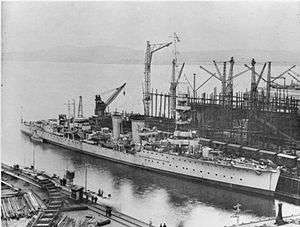HMS Caradoc (D60)
 | |
| History | |
|---|---|
| Class and type: | C-class light cruiser |
| Name: | HMS Caradoc |
| Builder: | Scotts Shipbuilding and Engineering Company, Greenock |
| Laid down: | 21 February 1916 |
| Launched: | 23 December 1916 |
| Commissioned: | 15 June 1917 |
| Reclassified: | Became a base ship, April 1944 |
| Fate: | Sold for scrap, 5 April 1946 |
| General characteristics (as built) | |
| Class & type: | C-class light cruiser |
| Displacement: | 4,238 long tons (4,306 t) |
| Length: | |
| Beam: | 42 ft 3 in (12.9 m) |
| Draught: | 18 ft 9 in (5.72 m) (mean, deep load) |
| Installed power: |
|
| Propulsion: | 2 × shafts; 2 × geared steam turbines |
| Speed: | 29 kn (54 km/h; 33 mph) |
| Complement: | 438 |
| Armament: |
|
| Armour: |
|
HMS Caradoc was a C-class light cruiser built for the Royal Navy during World War I. She was part of the Caledon sub-class of the C class. She survived both world wars to be scrapped in 1948.
Design and description
The Caledon sub-class was a slightly larger and improved version of the preceding Centaur sub-class with a more powerful armament. The ships were 450 feet 6 inches (137.3 m) long overall, with a beam of 42 feet 3 inches (12.9 m) and a deep draught of 18 feet 9 inches (5.7 m). Displacement was 4,238 long tons (4,306 t) at normal and 4,911 long tons (4,990 t) at deep load.[1] Caradoc was powered by two Parsons steam turbines, each driving one propeller shaft, which produced a total of 40,000 indicated horsepower (30,000 kW). The turbines used steam generated by six Yarrow boilers which gave her a speed of about 29 knots (54 km/h; 33 mph). She carried 935 long tons (950 t) tons of fuel oil. The ship had a crew of about 400 officers and other ranks; this increased to 437 when serving as a flagship.[2]
The main armament of the Caledon-class ships consisted of five BL 6-inch (152 mm) Mk XII guns that were mounted on the centreline. One gun was forward of the bridge, two were fore and aft of the two funnels and the last two were in the stern, with one gun superfiring over the rearmost gun. The two QF 3-inch (76 mm) 20-cwt anti-aircraft guns were positioned abreast of the fore funnel. The torpedo armament of the Caledons was four times more powerful than that of the Centaurs, with eight 21 in (533 mm) torpedo tubes in four twin mounts, two on each broadside.[2]
Construction and career
Caradoc was built by Scotts Shipbuilding and Engineering Company at their Greenock shipyard. She was laid down on 21 February 1916, launched on 23 December 1916 and completed and commissioned on 15 June 1917. She formed part of the 6th Light Cruiser Squadron of the Grand Fleet in common with the other ships of the Caledon subgroup. With her sister HMS Cassandra, she ran aground on Fair Isle on 15 August 1917. Both ships were successfully refloated.[2]
Inter-war years
The ship spent most of her time between the World Wars overseas or in reserve with deployments to the Mediterranean, the Far East and the North America and West Indies Station.[3]
Second World War
Caradoc was deployed into the Atlantic Ocean on the outbreak of war and assigned to operate off the North American coast. On 23 October 1939 the light cruiser HMS Orion and the Canadian destroyer HMCS Saguenay intercepted the German tanker Emmy Friedrich. When the Caradoc arrived on the scene, the Germans scuttled their ship to prevent her capture. On 11 December 1940 the German blockade runner Rhein was intercepted by the Dutch sloop HNLMS Van Kinsbergen west of the Florida Strait. The Rhein was set on fire by her own crew to prevent her capture, and the wreck was sunk later that day by Caradoc. She became a base ship in April 1944, and after the end of the war was considered obsolete. She was sold for scrap on 5 April 1946 and subsequently broken up at Briton Ferry, Wales.[3]
Notes
- ↑ "Cwt" is the abbreviation for hundredweight, 20 cwt referring to the weight of the gun.
Footnotes
Bibliography
- Chesneau, Roger, ed. (1980). Conway's All the World's Fighting Ships 1922–1946. Greenwich, UK: Conway Maritime Press. ISBN 0-85177-146-7.
- Colledge, J. J.; Warlow, Ben (2006) [1969]. Ships of the Royal Navy: The Complete Record of all Fighting Ships of the Royal Navy (Rev. ed.). London: Chatham Publishing. ISBN 978-1-86176-281-8. OCLC 67375475.
- Friedman, Norman (2010). British Cruisers: Two World Wars and After. Barnsley, South Yorkshire, UK: Seaforth. ISBN 978-1-59114-078-8.
- Friedman, Norman (2011). Naval Weapons of World War One. Barnsley, South Yorkshire, UK: Seaforth. ISBN 978-1-84832-100-7.
- Gardiner, Robert & Gray, Randal, eds. (1984). Conway's All the World's Fighting Ships: 1906–1921. Annapolis, Maryland: Naval Institute Press. ISBN 0-85177-245-5.
- Newbolt, Henry (1996). Naval Operations. History of the Great War Based on Official Documents V (reprint of the 1931 ed.). Nashville, Tennessee: Battery Press. ISBN 0-89839-255-1.
- Raven, Alan & Roberts, John (1980). British Cruisers of World War Two. Annapolis, Maryland: Naval Institute Press. ISBN 0-87021-922-7.
- Rohwer, Jürgen (2005). Chronology of the War at Sea 1939-1945: The Naval History of World War Two (Third Revised ed.). Annapolis, Maryland: Naval Institute Press. ISBN 1-59114-119-2.
- Whitley, M. J. (1995). Cruisers of World War Two: An International Encyclopedia. London: Cassell. ISBN 1-86019-874-0.
External links
| ||||||||||||||||||||||||||||||||||